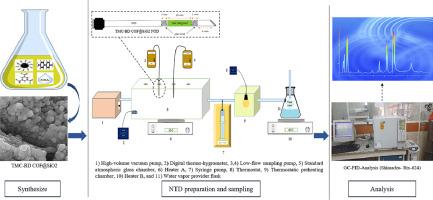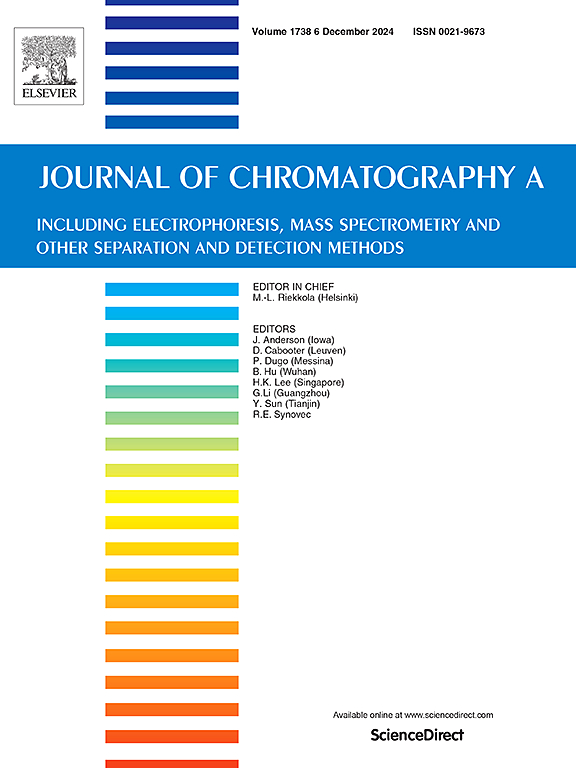化学锚定在二氧化硅纳米颗粒上的酰胺基共价有机框架,用于空气中卤代烃的顶空微量萃取采样
IF 3.8
2区 化学
Q1 BIOCHEMICAL RESEARCH METHODS
引用次数: 0
摘要
利用与二氧化硅纳米颗粒化学键合的酰胺基共价有机框架(COF),开发了一种针式捕集器(NTD)。NTD 与气相色谱-火焰离子化检测(GC-FID)相结合,用于空气中卤代烃(HHC)的顶空微萃取分析。使用傅立叶变换红外光谱(FT-IR)、X 射线衍射分析(XRD)、透射电子显微镜(TEM)和场发射扫描电子显微镜(FE-SEM)技术对吸附剂进行了表征。采用响应面方法学(RSM)和中心复合设计(CCD)评估了实验变量的最佳值,从而减少了实验次数、材料消耗、成本和时间。解吸时间和温度的最佳值分别为 5 分钟和 260 °C。在 0.5 - 3 倍职业接触限值 (OEL) 的范围内研究了突破体积 (BtV),发现其最佳值为 1200 毫升。最佳采样温度和相对湿度(RH)分别为 20 °C 和 15%。方法的检出限(LOD)和定量限(LOQ)分别为 0.013 至 0.077 μg l-1 和 0.041 至 0.21 μg l-1,线性动态范围(LDR)为 0.04 至 100 μg l-1。该方法的重复性和再现性(RSD %)分别为 5.3 - 6.4 % 和 4.7 - 6.9 %。经统计验证,NTD-GC-FID 方法与 NIOSH 1003 标准程序在实际工作场所空气样本中采样和测定 HHCs 的结果一致,表明所开发的方法可靠、准确。本文章由计算机程序翻译,如有差异,请以英文原文为准。

An amide-based covalent organic framework chemically anchored on silica nanoparticles for headspace microextraction sampling of halogenated hydrocarbons in air
A needle trap device (NTD) was developed using an amide-based covalent-organic framework (COF), chemically bonded to silica nanoparticles. The NTD was coupled with gas chromatography-flame ionization detection (GC-FID) and employed for the headspace microextraction analysis of halogenated hydrocarbons (HHCs) in the air. The adsorbent was characterized using Fourier-transform infrared spectroscopy (FT-IR), X-ray diffraction analysis (XRD), transmission electron microscopy (TEM), and field-emission scanning electron microscopy (FE-SEM) techniques.
Optimal values for the experimental variables were assessed using response surface methodology (RSM) with a central composite design (CCD), thereby reducing the number of experiments, material consumption, costs, and time. The optimal values for desorption time and temperature were obtained 5 min and 260 °C, respectively. Breakthrough volume (BtV) was studied over the range of 0.5 - 3 times the occupational exposure limit (OEL) and its optimal value was found to be 1200 mL. The optimal sampling temperature and relative humidity (RH) were obtained 20 °C, and 15 %, respectively. The limits of detection (LODs) and limits of quantification (LOQs) were ranged from 0.013 to 0.077 μg l-1 and 0.041 to 0.21 μg l-1, respectively, with a linear dynamic range (LDR) of 0.04 to 100 μg l-1. The method's repeatability and reproducibility (RSD %) were observed over the ranges of 5.3 - 6.4 % and 4.7 -6.9 %, respectively. A statistically validated agreement was observed between the NTD-GC-FID method and the NIOSH 1003 standard procedure for the sampling and determination of HHCs in real workplace air samples, demonstrating the reliability and accuracy of the developed approach.
求助全文
通过发布文献求助,成功后即可免费获取论文全文。
去求助
来源期刊

Journal of Chromatography A
化学-分析化学
CiteScore
7.90
自引率
14.60%
发文量
742
审稿时长
45 days
期刊介绍:
The Journal of Chromatography A provides a forum for the publication of original research and critical reviews on all aspects of fundamental and applied separation science. The scope of the journal includes chromatography and related techniques, electromigration techniques (e.g. electrophoresis, electrochromatography), hyphenated and other multi-dimensional techniques, sample preparation, and detection methods such as mass spectrometry. Contributions consist mainly of research papers dealing with the theory of separation methods, instrumental developments and analytical and preparative applications of general interest.
 求助内容:
求助内容: 应助结果提醒方式:
应助结果提醒方式:


